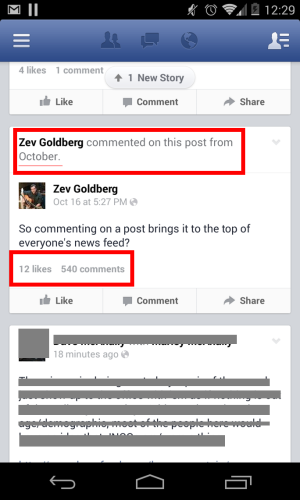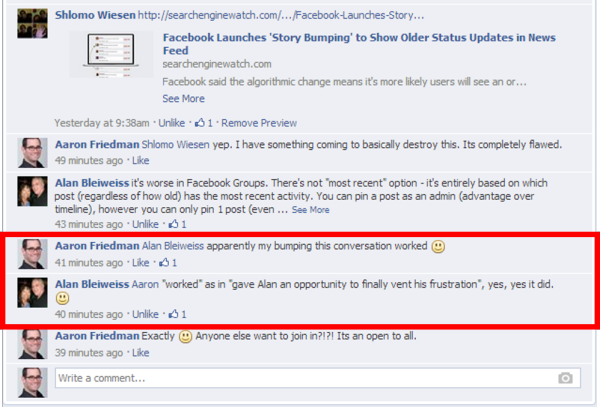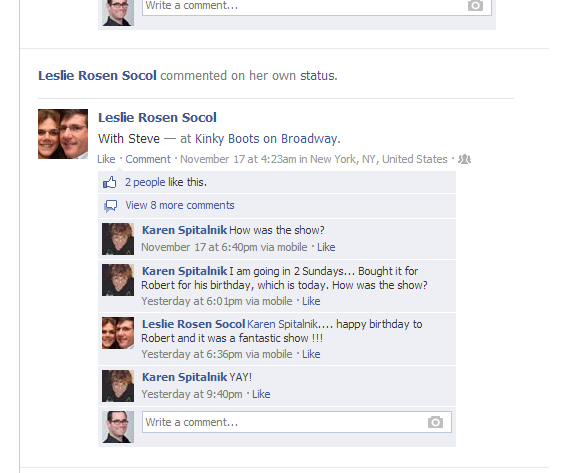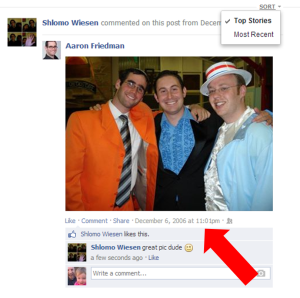Facebook’s Flawed News Feed Bumping & The Rebirth Of Bad Content
Personally speaking, I have no problem that Facebook is making changes to the news feed. I also have no problem that it has started story bumping. But I do fundamentally have a problem with how the company is doing this. Bringing Missed Content Back to Life What Facebook is trying to achieve is actually not a […]
Personally speaking, I have no problem that Facebook is making changes to the news feed. I also have no problem that it has started story bumping. But I do fundamentally have a problem with how the company is doing this.
Bringing Missed Content Back to Life
What Facebook is trying to achieve is actually not a bad thing. I miss content all the time. It happens. So if that piece is popular among my friends, then, truth be told, I do probably want to see it. That being said, story bumping in its current form is majorly flawed. Why? Because of this post from October 16th at 5:27PM

I took this screen shot on December 4th 2013 at 12:29AM when it resurfaced into the top of my news feed for the 5th time. Trolling Facebook #FTW.
That is, by far, the most extreme example I have, but it nevertheless helped me decide to do some real-time testing, going back to the early days of Facebook posting.
I asked some of my teammates to go back in time to my early posts and add a simple “like” or comment (thanks for helping my Klout score, suckers!). Sure enough, it’s actually that simple! Talk about manipulating social media. The following screenshots came rolling in (Note: these screenshots did not come from my own news feed):

Hot Cocoa and Peppermint schnapps… Totally not relevant to today, aside from the fact that now I want some.
And how about my neighbor’s post, which I commented on last week causing it to immediately showed up in my wife’s news feed?
Not to mention the “miracle images” from this past Hanukkah which lasted more than 8 days. My in-laws came to visit us, and a week later, when my mother in-law’s friends decided to finally log in and “like” the images she was tagged in, the images jumped right back up to where they started. A great miracle happened here!
All In Favor Say Giddyup!
Despite all my complaints, I am actually in favor of this move. I say Giddyup! Publishers and content creators will argue that the web is a bottomless pit of content due to algorithms like QDF (which stands for “query deserved freshness”) by Google which rewards “fresh” content, even if its not the most meritorious.
Facebook will argue that “search” is flawed and it is trying to correct the wrong. The concept of resurfacing content is actually a great one. It meant that SEO Alan Bleiweiss was able to comment on a post he had originally missed.

Great Concept, Poor Execution
All that said, a post should not reappear in my news feed when my Grandmother’s friend on Facebook “happens” to notice that my grandmother was tagged in a post, and “happens” to like it, and then sits there wondering what kind of ripple in the space time continuum she just created.
And, similarly, when someone comments on a post from three months ago, or worse, five years ago, which has had no activity in years, Facebook may make the assumption that it is still relevant and therefore worth resurfacing. In reality, it’s not.
How Can Facebook Fix This?
Well, we know Facebook has gotten rid of “Edgerank,” but I have a few ideas which could help Facebook fix some of these problems.
• Take Into Account The Age And Type Of Post. Five-year-old images of a friend’s lunch and selfies should never resurface. I don’t care if it was the best meal in the world or the cutest duck face around. That just has to stop. Solution: Be wary of ancient posts and those whose content has a limited shelf life. In many cases, just the date should be a dead giveaway.
• Level Of Initial Interaction. Good posts can get lost, too. Maybe you posted at the wrong time, it got a small amount of buzz, but then everyone left for the day and the poor post went to status notification limbo. Solution: The fact that it had initial interaction should serve as a sign to Facebook that there is potential here. But with posts that initially had little to no interaction — that’s probably a good sign that it’s not so relevant.
• Connections Of Connections May Not Be My Connections. Facebook should be able to understand who my connections are and how relevant their connections are to me. Chances are if I am not friends with that person, or they have been suggested to me as a friend and I didn’t add them, it’s likely because I don’t want to be connected to them. And I certainly don’t want to see an old piece of content because they liked it. Solution: Simply using this as a relevancy metric will create a more personalized and relevant Facebook experience.
Sounds an awful lot like Edgerank doesn’t it?! :) I imagine these are points that Facebook takes into consideration, but over the past few months, it seems like it’s been getting worse.
How Can Marketers Take advantage Of This?
Just start bumping. Seriously. Bump until your heart is content…

My Aunt went to a Broadway show… and apparently she was there for over 24 hours because someone commented on it.
Of course, I am joking (kind of). I have seen an unreal amount of my own personal content re-surfaced, sometimes in ways that shouldn’t have happened. It is probably not wise to abuse the system, but I won’t tell you not to take advantage of this right now to get your brand’s face out there.
The real problem here is that an “easy-to-game” platform leaves Facebook vulnerable to “black-hat” actors who only want to get more visibility for their brands, not necessarily adding any real value to users. In that environment, it’s the legitimate marketers who don’t resort to such tactics that are at a disadvantage.
Or is Facebook telling us we should be doing something else with our own content? That as marketers, it’s our responsibility to not let our most impressive content go to the status update grave?
What This Really Means For Marketers
I think (and hope) the system will evolve, and become more intuitive. Maybe the company will even take into account some of my feedback.
But either way, now more than ever, this means it’s time for marketers to become more conversational. It’s time to re-engage our audiences. Now is the time to encourage users to share our content, and now is the time to start getting more active on social media, because soon, if you can’t learn to control the conversation, you won’t be part of it.
Contributing authors are invited to create content for MarTech and are chosen for their expertise and contribution to the search community. Our contributors work under the oversight of the editorial staff and contributions are checked for quality and relevance to our readers. MarTech is owned by Semrush. Contributor was not asked to make any direct or indirect mentions of Semrush. The opinions they express are their own.
Related stories
New on MarTech

